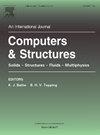Multi-agent deep reinforcement learning for resilience optimization of building structures considering utility interactions for functionality
IF 4.4
2区 工程技术
Q1 COMPUTER SCIENCE, INTERDISCIPLINARY APPLICATIONS
引用次数: 0
Abstract
The resilience optimization of the built environment under extreme events with building structures and interdependent physical infrastructure systems is inefficient due to the large action spaces of pre-hazard mitigation alternatives. Hence, a Multi-Agent Deep Deterministic Policy Gradient (MADDPG) based resilience optimization framework is proposed herein to enhance the resilience of the built environment with large mitigation action spaces. The proposed framework is divided into two parts including (1) Performance-Based Environment (PBE) to assess the resilience of the building structures under given hazard scenarios considering dependencies and interdependencies of the physical infrastructure systems, and (2) MADDPG for resilience optimization of the interdependent building structures given minimal mitigation and repair costs. The PBE is developed to assess the consequences of the mitigation actions under hazard by utilizing steps including component consequence and recovery assessment, network modeling and functionality assessment, and portfolio consequence and resilience assessment. The multi-agents for resilience optimization utilize Deep Deterministic Policy Gradients (DDPG) including actor and critic networks to learn to optimize the mitigation actions by maximizing the cumulative reward function given the hazard scenarios. The proposed framework is illustrated on a built environment with building structures and two physical infrastructure systems including a Water Network (WN) and an Electrical Power Network (EPN) system. The provided framework efficiently optimizes complex, interdependent, and large infrastructure systems under extreme events by utilizing physics-based environments and artificial intelligence.
基于多智能体深度强化学习的建筑结构弹性优化
极端事件下建筑结构和相互依赖的物理基础设施系统的建筑环境弹性优化是低效的,因为灾害前缓解方案的行动空间很大。为此,本文提出了一种基于多智能体深度确定性策略梯度(madpg)的弹性优化框架,以增强具有大缓解行动空间的建筑环境的弹性。提出的框架分为两部分,包括:(1)基于性能的环境(PBE),考虑物理基础设施系统的依赖性和相互依赖性,评估特定灾害情景下建筑结构的弹性;(2)基于最小缓解和修复成本的相互依存建筑结构的弹性优化madpg。开发PBE是为了评估风险下缓解行动的后果,采用的步骤包括组件后果和恢复评估、网络建模和功能评估以及组合后果和恢复能力评估。弹性优化的多智能体利用深度确定性策略梯度(Deep Deterministic Policy Gradients, DDPG),包括行动者和批判者网络,在给定危险情景的情况下,通过最大化累积奖励函数来学习优化缓解行动。建议的框架是在一个有建筑结构和两个物理基础设施系统的建成环境中说明的,包括一个供水网络(WN)和一个电力网络(EPN)系统。提供的框架通过利用基于物理的环境和人工智能,在极端事件下有效地优化复杂、相互依赖的大型基础设施系统。
本文章由计算机程序翻译,如有差异,请以英文原文为准。
求助全文
约1分钟内获得全文
求助全文
来源期刊

Computers & Structures
工程技术-工程:土木
CiteScore
8.80
自引率
6.40%
发文量
122
审稿时长
33 days
期刊介绍:
Computers & Structures publishes advances in the development and use of computational methods for the solution of problems in engineering and the sciences. The range of appropriate contributions is wide, and includes papers on establishing appropriate mathematical models and their numerical solution in all areas of mechanics. The journal also includes articles that present a substantial review of a field in the topics of the journal.
 求助内容:
求助内容: 应助结果提醒方式:
应助结果提醒方式:


